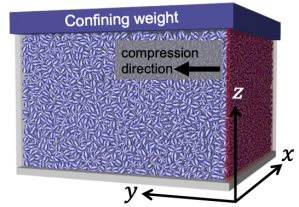In Terry Pratchett’s fantasy novel Soul Music, rock ’n roll arrives in Ankh-Morpork. Ankh-Morpork resembles the London of yesteryear—teeming with heroes and cutthroats, palaces and squalor—but also houses vampires, golems, wizards, and a sentient suitcase. Against this backdrop, a young harpist stumbles upon a mysterious guitar. He forms a band with a dwarf and with a troll who plays tuned rocks, after which the trio calls its style “Music with Rocks In.” The rest of the story consists of satire, drums, and rocks that roll.
The topic of rolling rocks sounds like it should elicit more yawns than an Elvis concert elicited screams. But rocks’ rolling helped recent University of Maryland physics PhD student Zackery Benson win a National Research Council Fellowship. He and his advisor, Wolfgang Losert, converted me into a fan of granular flow.
What I’ve been studying recently. Kind of.
Grains make up materials throughout the galaxy, such as the substance of avalanches. Many granular materials undergo repeated forcing by their environments. For instance, the grains that form an asteroid suffer bombardment from particles flying through outer space. The gravel beneath train tracks is compressed whenever a train passes.
Often, a pattern characterizes the forces in a granular system’s environment. For instance, trains in a particular weight class may traverse some patch of gravel, and the trains may arrive with a particular frequency. Some granular systems come to encode information about those patterns in their microscopic configurations and large-scale properties. So granular flow—little rocks that roll—can impact materials science, engineering, geophysics, and thermodynamics.
Granular flow sounds so elementary, you might expect us to have known everything about it since long before the Beatles’ time. But we didn’t even know until recently how to measure rolling in granular flows.
Envision a grain as a tiny sphere, like a globe of the Earth. Scientists focused mostly on how far grains are translated through space in a flow, analogouslly to how far a globe travels across a desktop if flicked. Recently, scientists measured how far a grain rotates about one axis, like a globe fixed in a frame. Sans frame, though, a globe can spin about more than one axis—about three independent axes. Zack performed the first measurement of all the rotations and translations of all the particles in a granular flow.
Each grain was an acrylic bead about as wide as my pinky nail. Two holes were drilled into each bead, forming an X, for reasons I’ll explain.
Image credit: Benson et al., Phys. Rev. Lett. 129, 048001 (2022).
Zack dumped over 10,000 beads into a rectangular container. Then, he poured in a fluid that filled the spaces between the grains. Placing a weight atop the grains, he exerted a constant pressure on them. Zack would push one of the container’s walls inward, compressing the grains similarly to how a train compresses gravel. Then, he’d decompress the beads. He repeated this compression cycle many times.
Image credit: Benson et al., Phys. Rev. E 103, 062906 (2021).
Each cycle consisted of many steps: Zack would compress the beads a tiny amount, pause, snap pictures, and then compress a tiny amount more. During each pause, the camera activated a fluorescent dye in the fluid, which looked clear in the photographs. Lacking the fluorescent dye, the beads showed up as dark patches. Clear X’s cut through the dark patches, as dye filled the cavities drilled into the beads. From the X’s, Zack inferred every grain’s orientation. He inferred how every grain rotated by comparing the orientation in one snapshot with the orientation in the next snapshot.
Image credit: Benson et al., Phys. Rev. Lett. 129, 048001 (2022).
Wolfgang’s lab had been trying for fifteen years to measure all the motions in a granular flow. The feat required experimental and computational skill. I appreciated the chance to play a minor role, in analyzing the data. Physical Review Letters published our paper last month.
From Zack’s measurements, we learned about the unique roles played by rotations in granular flow. For instance, rotations dominate the motion in a granular system’s bulk, far from the container’s walls. Importantly, the bulk dissipates the most energy. Also, whereas translations are reversible—however far grains shift while compressed, they tend to shift oppositely while decompressed—rotations are not. Such irreversibility can contribute to materials’ aging.
In Soul Music, the spirit of rock ’n roll—conceived of as a force in its own right—offers the guitarist the opportunity to never age. He can live fast, die young, and enjoy immortality as a legend, for his guitar comes from a dusty little shop not entirely of Ankh-Morpork’s world. Such shops deal in fate and fortune, the author maintains. Doing so, he takes a dig at the River Ankh, which flows through the city of Ankh-Morpork. The Ankh’s waters hold so much garbage, excrement, midnight victims, and other muck that they scarcely count as waters:
And there was even an Ankh-Morpork legend, wasn’t there, about some old drum [ . . . ] that was supposed to bang itself if an enemy fleet was seen sailing up the Ankh? The legend had died out in recent centuries, partly because this was the Age of Reason and also because no enemy fleet could sail up the Ankh without a gang of men with shovels going in front.
Such a drum would qualify as magic easily, but don’t underestimate the sludge. As a granular-flow system, it’s more incredible than you might expect.






